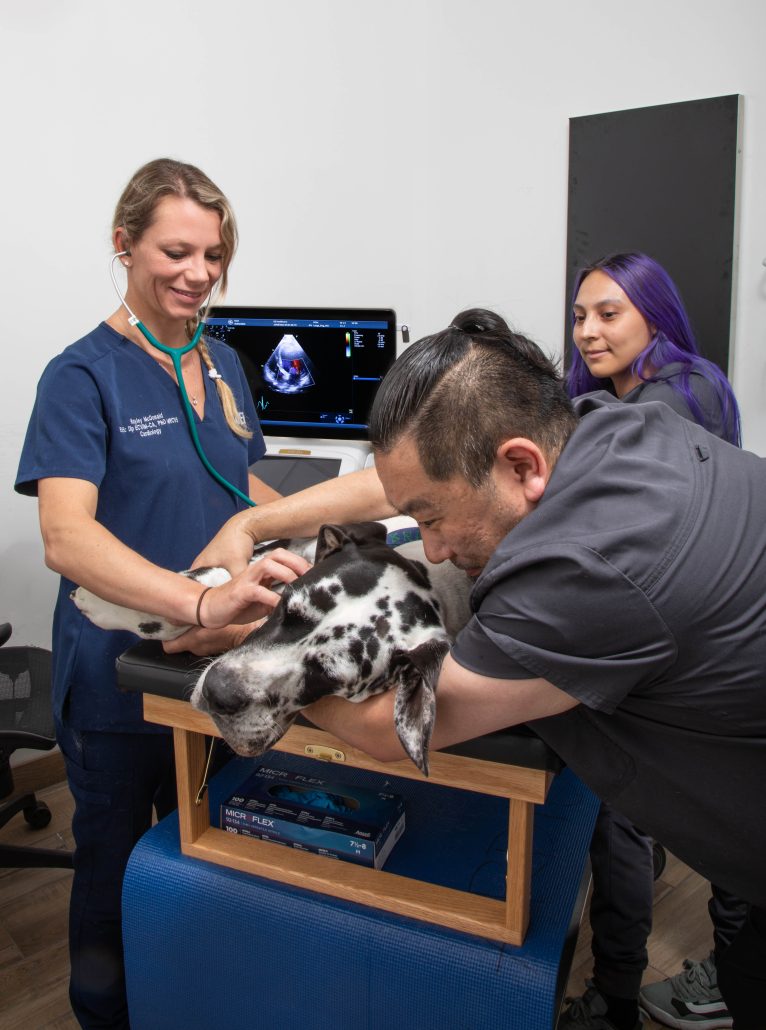What You Required to Know Regarding Veterinary Providers: An Introduction of Diagnostic Equipments and Procedures
Vet services play an important duty in preserving the health and wellness of family pets. Routine examinations can expose hidden health problems beforehand. Numerous analysis tools and procedures, such as blood tests and imaging techniques, provide necessary understandings right into an animal's wellness. Understanding these approaches is key for family pet owners. What certain analysis procedures are most generally utilized, and just how can they influence a pet's therapy plan?
Relevance of Regular Veterinary Exams
While many animal proprietors might undervalue the importance of normal vet check-ups, these visits are important for preserving a pet's overall health. Regular visits to the veterinarian permit for early discovery of possible health problems before they intensify into serious troubles. Regular exams usually consist of inoculations, which are essential for stopping infectious conditions that might seriously impact a family pet's wellness. Furthermore, these appointments provide a possibility for veterinarians to analyze the animal's weight, oral health and wellness, and general condition, making sure that the animal is flourishing. During these visits, animal owners can also receive useful recommendations on diet plan, workout, and precautionary treatment tailored to their certain family pet's demands.
Typical Analysis Procedures in Veterinary Medication
In vet medicine, accurate medical diagnosis is essential for effective therapy. Usual analysis procedures include blood testing techniques, progressed imaging modern technologies, and urinalysis, each playing a substantial function in determining health and wellness issues. Comprehending these methods improves the ability to offer suitable take care of pet patients.
Blood Examining Methods
Blood testing strategies function as vital diagnostic devices in veterinary medication, enabling vets to evaluate the wellness of animals properly. These methods involve accumulating blood examples to examine numerous parts, such as white and red blood cells, platelets, and biochemical markers. Common tests consist of complete blood counts (CBC), which review total health and discover infections, and biochemical panels, which analyze body organ function and metabolic condition. Furthermore, serological examinations can determine certain diseases via antibody discovery. Blood screening is minimally intrusive and gives important details that assists in identifying problems, keeping an eye on health condition, and evaluating reactions to therapies. Overall, these methods play a vital role in making sure perfect take care of pet dogs and animals alike.
Imaging Technologies Used
Analysis imaging innovations are essential tools in veterinary medication, matching blood testing methods by supplying aesthetic insights into an animal's interior frameworks. Typical imaging methods consist of X-rays, which work for evaluating bone fractures and finding international things, and ultrasound, which permits for real-time visualization of soft tissues and organs. Magnetic resonance imaging (MRI) uses detailed photos of complicated anatomical locations, especially in neurological assessments. Calculated tomography (CT) supplies cross-sectional photos, enhancing diagnostic accuracy for various conditions. Each of these innovations aids veterinarians in identifying health problems, intending treatments, and keeping track of recuperation. By incorporating imaging technologies, veterinary specialists can better evaluate an animal's health and wellness and make notified choices regarding their treatment.
Urinalysis and Diagnostics
Urinalysis acts as a critical analysis device in vet medication, giving beneficial understandings into a pet's overall health and wellness and helping in the discovery of numerous conditions. This non-invasive treatment analyzes urine samples to evaluate kidney function, hydration standing, and metabolic disorders. Typical elements taken a look at consist of specific gravity, pH levels, sugar, healthy proteins, and the presence of blood or microorganisms. Unusual findings can suggest concerns such as urinary system system infections, diabetic issues mellitus, or kidney illness. To boost diagnostic accuracy, urinalysis is usually executed combined with other tests, such as blood job and imaging researches. Early detection with urinalysis can result in prompt interventions, improving the diagnosis for lots of vet people. It is an essential facet of extensive veterinary treatment.
Understanding Blood Tests and Lab Evaluation
Understanding blood examinations and research laboratory analysis is crucial in veterinary medicine as it assists in diagnosing numerous health problems in animals. Various kinds of blood tests provide important information concerning an animal's inner state, while translating lab results requires cautious consideration of many variables. This section will check out the sorts of blood tests available and the relevance of their outcomes.
Kinds Of Blood Examinations
Blood examinations play an important role in veterinary medicine, offering necessary understandings right into a pet's wellness condition. Different kinds of blood examinations are used, each offering various functions. Total blood matters (CBC) assess overall health and spot conditions such as anemia or infection. Biochemical profiles evaluate organ feature by gauging enzymes and electrolytes, offering insights right into metabolic health. Serological examinations recognize details antibodies or virus, assisting in the medical diagnosis of infections or autoimmune illness. Blood inputting guarantees safe transfusions, while coagulation examinations assess the blood's capability to clot, vital for operations. These tests collectively boost medical diagnosis, treatment planning, and surveillance of an animal's health, highlighting the relevance of detailed research laboratory analysis in veterinary treatment.

Interpreting Lab Outcomes
A thorough analysis of lab outcomes is essential for accurate diagnosis and treatment in vet medication. Analyzing laboratory results requires an understanding of normal reference varieties and the significance of variances. Blood examinations can disclose numerous wellness indications, such as organ feature, electrolyte equilibrium, and the visibility of infections. Vets have to think about the whole professional image, consisting of the pet's history, health examination searchings for, and any type of symptoms presented. Variants in results might occur from aspects such as age, type, and underlying health and wellness problems. Laboratory outcomes should not be viewed in isolation but rather as part of an all-inclusive diagnostic method. Accurate interpretation permits customized treatment plans and better end results for vet people.
Imaging Techniques: X-rays, Ultrasounds, and Beyond
Imaging strategies are important tools in vet medicine, providing critical understandings into the health and health of animals. Among one of the most frequently used approaches are Ultrasounds and x-rays. X-rays are vital for envisioning bone structures, helping vets determine cracks, tumors, or international items. This method is fast and non-invasive, making it ideal for immediate situations.Ultrasounds, on the other hand, use acoustic waves to produce images of soft cells and organs. This method is particularly valuable for taking a look at the heart, abdomen, and reproductive body organs, allowing veterinarians to assess problems like fluid build-up or organ abnormalities.Beyond X-rays and ultrasounds, progressed imaging methods such as computed tomography (CT) and magnetic vibration imaging (MRI) are increasingly made use of in veterinary method. These approaches provide thorough cross-sectional images, boosting the accuracy of diagnoses and treatment plans. Ultrasound For Dogs. continue reading this Generally, imaging strategies play a vital duty in ensuring efficient vet treatment
The Role of Biopsies in Diagnosing Animal Wellness Issues
Accuracy in diagnosing health and wellness concerns in animals often depends upon making use of biopsies, which give definitive info regarding cells abnormalities. A biopsy involves the elimination of a tiny example of tissue for assessment under a microscope, allowing veterinarians to determine numerous problems, consisting of infections, tumors, and inflammatory illness. This diagnostic device is essential for differentiating between malignant and benign growths, assisting therapy decisions, and reviewing the extent of a condition.Biopsies can be performed using numerous strategies, such as needle desire, incisional biopsies, or check my site excisional biopsies, relying on the area and sort of cells entailed. The selection of approach might impact healing time and the amount of tissue gathered. Ultimately, the info obtained from a biopsy can cause targeted therapies, improving outcomes for animals dealing with major health and wellness obstacles. Vets highlight the value of this procedure in accomplishing precise diagnoses and effective therapy plans.
Advanced Diagnostic Tools: Endoscopy and CT Checks

Advanced analysis tools, such as endoscopy and CT scans, play a crucial function in modern vet medicine, using non-invasive methods to picture internal structures and detect various problems in pets. Endoscopy includes the usage of a versatile tube outfitted with a video camera, permitting veterinarians to take a look at the gastrointestinal tract and breathing system directly. This method can disclose irregularities such as lumps, foreign bodies, or swelling, allowing targeted therapy plans.CT scans, on the other hand, use advanced imaging technology to produce thorough cross-sectional pictures of the body (CT Scans For Dogs). This approach is particularly helpful for examining facility frameworks like the brain, back, and joints. By providing high-resolution pictures, CT scans aid veterinarians in identifying concerns that may not appear with traditional radiography. Together, these sophisticated devices improve analysis precision, boost therapy outcomes, and eventually add to far better total pet health and wellness administration

Analyzing Test Outcomes: What Animal Owners Need To Know
Comprehending examination results can be a tough task for pet dog owners, specifically after sophisticated treatments like endoscopy and CT scans have been done. Interpreting these outcomes requires a grasp of clinical terminology and a clear understanding of what the searchings for suggest concerning the animal's wellness. Veterinarians typically provide explanations, yet the complexity of the results can still bring about confusion.Pet owners ought to proactively engage in conversations with their vets, asking questions to clear up any kind of unpredictabilities. It is necessary to comprehend typical versus irregular outcomes and the implications for the family pet's treatment plan. In addition, acknowledging that some outcomes might require further testing or tracking can aid owners stay notified regarding their pet dog's wellness trip. Ultimately, a collaborative method between family pet proprietors and vet professionals promotes far better health and wellness results and improves the general care experience for family pets.
Regularly Asked Inquiries
Just how Do I Pick the Right Vet Center for My Family pet?
Selecting the ideal veterinary center involves researching local options, evaluating qualifications, visiting centers, and analyzing team communications (CT Scans For Animals). Focusing on suggestions from trusted sources can help assure the very best treatment and setting for a pet dog's wellness requirements
What Should I Do if My Pet Dog Declines to Go to the Vet?
When a pet refuses to head to the veterinarian, it's suggested to continue to be tranquil, use deals with or playthings to tempt them, and take into consideration arranging a home see if stress and anxiety continues. Patience and positive reinforcement are crucial.
Exist Telehealth Options for Vet Providers?
Telehealth options for vet services are progressively offered, enabling pet dog proprietors to seek advice from veterinarians remotely. These solutions allow conversations regarding health concerns, suggestions on small disorders, and follow-ups without requiring to check out a facility.
Just how Typically Should My Animal Have Dental Check-Ups?
The frequency of oral exams for pet dogs normally depends on their age and type. Normally, veterinarians suggest annual dental assessments, although some pet dogs might need even more constant visits to preserve excellent oral health and wellness.

What Are the Prices Associated With Veterinary Diagnostics?
The expenses related to veterinary diagnostics can differ widely, generally ranging from standard examinations like blood work to sophisticated imaging strategies. Aspects affecting costs include the clinic's place, devices utilized, and particular tests required for each and every pet. Vet solutions play an important role in maintaining the wellness of pets. While lots of pet owners might ignore the importance of regular vet check-ups, these appointments are important for maintaining a pet's overall health. Additionally, these consultations supply a have a peek here possibility for vets to assess the pet's weight, dental health, and overall problem, ensuring that the animal is flourishing. Precision in diagnosing health and wellness problems in animals usually pivots on the use of biopsies, which offer conclusive details concerning tissue irregularities. Furthermore, acknowledging that some results might call for more testing or monitoring can assist proprietors remain informed concerning their pet dog's wellness journey.